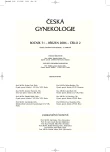Ursodeoxycholic Acid, S-adenosyl-L-methionine and their Combinations in the Treatment of Gestational Intrahepatic Cholestasis (ICP)
Authors:
T. Binder 1; P. Salaj 2; T. Zima 3; L. Vítek 3
Authors‘ workplace:
Gynekologicko-porodnická klinika 2. LF UK a FN Motol, Praha, přednosta doc. MUDr. L. Rob, CSc.
1; Ústav hematologie a krevní transfuze, Praha, ředitel prof. MUDr. P. Klener, DrSc.
2; Ústav klinické biochemie l. LF UK a VFN, Praha, přednosta prof. MUDr. T. Zima, DrSc.
3
Published in:
Ceska Gynekol 2006; 71(2): 92-98
Category:
Original Article
Overview
Seating:
¹Department of Obstet. Gynecol., 2nd Medical School Charles University and Teaching Hospital Motol, Prague, ²Institute of Haematology and Blood Transfusion Prague, ³Department of Clin. Bioch. General Teaching Hospital and lst Medical School, Charles University Prague, Czech Republic.
Aim of the Study:
To compare the efficacy of the monotherapy with ursodeoxycholic acid and S- adenosyl- L-methione with combined effect of both drugs in the treatment in pregnant women with intrahepatic cholestasis of pregnancy.
Methodology:
All women with singleton pregnancy at <36 weeks of gestation with moderate or severe form of ICP during January 1999 to June 2005 were enrolled. All were randomly assigned oral ursodeoxycholic acid (UDCA) 3 x 250mg daily or 500mg S–adenosyl–L-methione (SAMe) twice daily in slow running infusion for twelve days ongoing oral 500 mg twice daily until delivery. Haematological and biochemical parameters were evaluated every week. Intensive monitoring of the fetus with cardiotocography and utrasound were accompanied.
Results:
Of the 78 women enrolled, 25 received SAMe and 26 UDCA monotherapy. 27 women received combined therapy with both drugs. At enrolment, gestational age, duration of therapy, parity and biochemical characteristics were similar in the groups. All types of therapy improve the pruritus. The combined therapy and the monotherapy with UDCA led to improving of the serum concentrations of bile acids, asparate aminotranspherase, alanine aminotranspherase compared with monotherapy with SAMe. The differencies were statisticaly significant (p>0.01). The combined therapy led to quicker decrease of serum concentrations of bile acids and transaminases compared with UDCA monotherapy, however the results are only of borderline statistical significance. Gestational age at the time of labor and rate of prematurity were similar in all groups. No adverse effects were noted on the fetuses or neonates with either therapy.
Conclusions:
Ursodeoxycholic acid is effective in improving the biochemical parametres during the treatment of ICP. There is probably the synergistic effect with S adenosyl-L-methione. Whether the successful treatment influence the conditions of the fetus is not clear. The good perinatal outocome is probably more due to the precise monitoring of the intrauterine well-being of the fetus. The project is supported by IGA MZ CR (No. NH/7376-3).
Key words:
intrahepatic cholestasis of pregnancy, ursodeoxicholic acid, S-adenosyl-L-methionine.
Labels
Paediatric gynaecology Gynaecology and obstetrics Reproduction medicineArticle was published in
Czech Gynaecology

2006 Issue 2
Most read in this issue
- Embryo Quality Evaluation According to the Speed of the first Cleavage after Conventional IVF
- Serum Amyloid A as an Effective Marker for the Assessment of Surgical Trauma and Risk of Post-operative Complications
- Radical Parametrectomy in Women with Invasive Cervix Cancer after Previous Simple Hysterectomy
- Ursodeoxycholic Acid, S-adenosyl-L-methionine and their Combinations in the Treatment of Gestational Intrahepatic Cholestasis (ICP)
